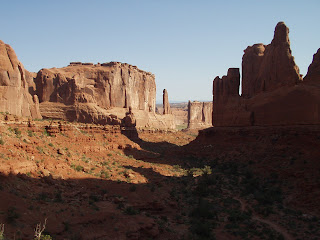

The park lies atop an underground salt bed that is basically responsible for the arches, spires, balance rocks, sandstone fins, and eroded monoliths of the sightseers Mecca. Thousands of feet of salt were in place 30 million years ago. Salt, under pressure, is unstable and as rock formed over the salt beds it was no match for the weight of the rock. The salt layers shifted, buckled, liquefied and repositioned itself thrusting the rock layers upward as domes and whole sections fell into the cavities. There are over 2,000 arches in this park alone. To be classified as an arch it has to be at least 3 feet and it does not matter how thin the arch actually is and as long as you can see light through it. Bob hiked on park ranger guided tour through the Fiery Furnace area. There are no trails in this area and some of the canyons, through the fins, were a tight squeeze and you actually had to position yourself up the rock in order to be able to pass through some areas. The hiking trails brought you close to many of the larger, more notable arches and balanced rocks. There were a number of easy trails that make this park accessible for most people.














